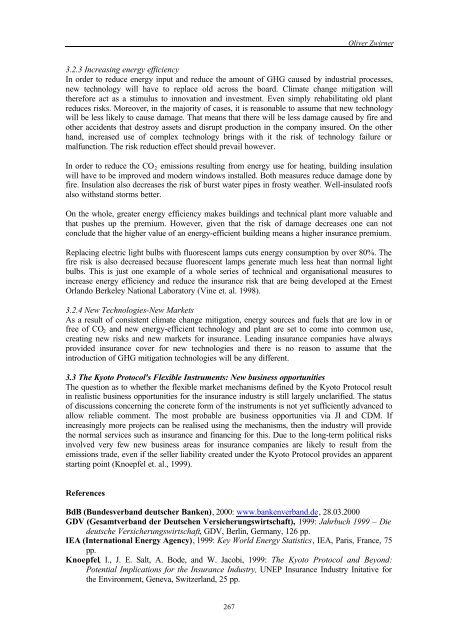sectoral economic costs and benefits of ghg mitigation - IPCC
sectoral economic costs and benefits of ghg mitigation - IPCC
sectoral economic costs and benefits of ghg mitigation - IPCC
Create successful ePaper yourself
Turn your PDF publications into a flip-book with our unique Google optimized e-Paper software.
Oliver Zwirner<br />
3.2.3 Increasing energy efficiency<br />
In order to reduce energy input <strong>and</strong> reduce the amount <strong>of</strong> GHG caused by industrial processes,<br />
new technology will have to replace old across the board. Climate change <strong>mitigation</strong> will<br />
therefore act as a stimulus to innovation <strong>and</strong> investment. Even simply rehabilitating old plant<br />
reduces risks. Moreover, in the majority <strong>of</strong> cases, it is reasonable to assume that new technology<br />
will be less likely to cause damage. That means that there will be less damage caused by fire <strong>and</strong><br />
other accidents that destroy assets <strong>and</strong> disrupt production in the company insured. On the other<br />
h<strong>and</strong>, increased use <strong>of</strong> complex technology brings with it the risk <strong>of</strong> technology failure or<br />
malfunction. The risk reduction effect should prevail however.<br />
In order to reduce the CO 2 emissions resulting from energy use for heating, building insulation<br />
will have to be improved <strong>and</strong> modern windows installed. Both measures reduce damage done by<br />
fire. Insulation also decreases the risk <strong>of</strong> burst water pipes in frosty weather. Well-insulated ro<strong>of</strong>s<br />
also withst<strong>and</strong> storms better.<br />
On the whole, greater energy efficiency makes buildings <strong>and</strong> technical plant more valuable <strong>and</strong><br />
that pushes up the premium. However, given that the risk <strong>of</strong> damage decreases one can not<br />
conclude that the higher value <strong>of</strong> an energy-efficient building means a higher insurance premium.<br />
Replacing electric light bulbs with fluorescent lamps cuts energy consumption by over 80%. The<br />
fire risk is also decreased because fluorescent lamps generate much less heat than normal light<br />
bulbs. This is just one example <strong>of</strong> a whole series <strong>of</strong> technical <strong>and</strong> organisational measures to<br />
increase energy efficiency <strong>and</strong> reduce the insurance risk that are being developed at the Ernest<br />
Orl<strong>and</strong>o Berkeley National Laboratory (Vine et. al. 1998).<br />
3.2.4 New Technologies-New Markets<br />
As a result <strong>of</strong> consistent climate change <strong>mitigation</strong>, energy sources <strong>and</strong> fuels that are low in or<br />
free <strong>of</strong> CO 2 <strong>and</strong> new energy-efficient technology <strong>and</strong> plant are set to come into common use,<br />
creating new risks <strong>and</strong> new markets for insurance. Leading insurance companies have always<br />
provided insurance cover for new technologies <strong>and</strong> there is no reason to assume that the<br />
introduction <strong>of</strong> GHG <strong>mitigation</strong> technologies will be any different.<br />
3.3 The Kyoto Protocol's Flexible Instruments: New business opportunities<br />
The question as to whether the flexible market mechanisms defined by the Kyoto Protocol result<br />
in realistic business opportunities for the insurance industry is still largely unclarified. The status<br />
<strong>of</strong> discussions concerning the concrete form <strong>of</strong> the instruments is not yet sufficiently advanced to<br />
allow reliable comment. The most probable are business opportunities via JI <strong>and</strong> CDM. If<br />
increasingly more projects can be realised using the mechanisms, then the industry will provide<br />
the normal services such as insurance <strong>and</strong> financing for this. Due to the long-term political risks<br />
involved very few new business areas for insurance companies are likely to result from the<br />
emissions trade, even if the seller liability created under the Kyoto Protocol provides an apparent<br />
starting point (Knoepfel et. al., 1999).<br />
References<br />
BdB (Bundesverb<strong>and</strong> deutscher Banken), 2000: www.bankenverb<strong>and</strong>.de, 28.03.2000<br />
GDV (Gesamtverb<strong>and</strong> der Deutschen Versicherungswirtschaft), 1999: Jahrbuch 1999 – Die<br />
deutsche Versicherungswirtschaft, GDV, Berlin, Germany, 126 pp.<br />
IEA (International Energy Agency), 1999: Key World Energy Statistics, IEA, Paris, France, 75<br />
pp.<br />
Knoepfel, I., J. E. Salt, A. Bode, <strong>and</strong> W. Jacobi, 1999: The Kyoto Protocol <strong>and</strong> Beyond:<br />
Potential Implications for the Insurance Industry, UNEP Insurance Industry Initative for<br />
the Environment, Geneva, Switzerl<strong>and</strong>, 25 pp.<br />
267
















